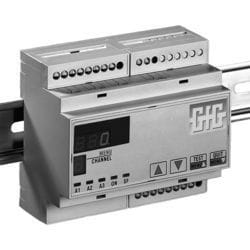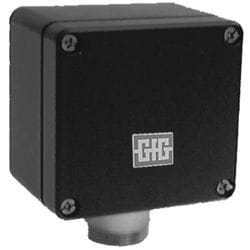Gas Detection Sensors - GfG Sensors
Micro III series
G1318___
Small, light and robust
The MICRO III is an extremely small instrument compared to other detectors. With its dimensions of only 47 x 88 x 25 mm (1.88 x 3.52 x 1 inches WxHxD), it weighs only 61 grams (2.135 oz) and can comfortably fit into a shirt pocket. A built-in clip secures the MICRO III safely to a belt or pocket. The casing is extremely shock and scratch resistant. The protection type IP 56 indicates that the instrument is sealed against dust and water. The MICRO III uses the AQUA-SHIELD (accessory sensor inlet)
which ensures that the monitor will provide excellent performance in harsh conditions.
More protection through easier operation
The G 201 and the G 202 is produced without buttons or switches. Therefore an operating error is completely eliminated and time consuming training is reduced.
With a single battery or accumulator, the MICRO III can measure and monitor up to nine months without interruption. The battery can simply be replaced. After a battery change, the MICRO III is immediately functional without any maintenance.
The plug-in smart sensor can be easily replaced. The MICRO III recognizes the new sensor type, another measuring gas, detection range, calibration curve, as well as alarm threshold values.
Numerous Features
The MICRO III comes standard with many features including automatic zeroing, Auto-Cal calibration, confidence bleep, battery check, and three factory set alarm points.
The following models are available:
G201 with loud alarm horn and bright alarm lamp
G202/G212 as G 201, additional: display for gas concentration, battery capacity and service control
G203/G213 as G 202, additional: Peak/ minimum calibration, TWA/STEL, control keys for display light and service functions.
All MICRO III devices feature audible or a visible confidence signal. Zero point adjustments can be carried out quickly and easily in fresh air.
Attachable pump
An electrical high-performance pump will take samples of gases from mines or tanks. The pump replaces the battery cover and is a fixed part of the instrument with its own power supply. The operation of the pump will have no influence on the operation time of the MICRO III.
Loud audible alarm
The audible alarm of the MICRO III has a changing frequency. Machinery noises do not interfere with the horn signal, like in the case of a monotone alarm horn. Simultaneously, two very bright, alternately flashing LED´s indicate a gas alarm. The LED´s are visible at 360°. The three alarm levels and the battery alarm
are clearly distinguishable.
Variations
G1318011 Micro III G202 Oxygen - 1yr sensor, up to 25 Vol%
G1318012 Micro III G202 Oxygen - 2yr sensor, up to 25 Vol%
G1318017 Micro III G202 Carbon Monoxide - slective,reduced H2 sensitivity, 300ppm
G1318015 Micro III G202 Carbon Monoxide - add. wams for H2S up to 300ppm
G1318127 Micro III G202 Ammonia - 1-1/2 year sensor, up to 200ppm
G1318128 Micro III G202 Ammonia - 2 year sensor, up to 200ppm
G1318021 Micro III G203 Oxygen - 1yr sensor, up to 25 Vol%
G1318022 Micro III G203 Oxygen - 2yr sensor, up to 25 Vol%
G1318027 Micro III G203 Carbon Monoxide - slective,reduced H2 sensitivity, 300ppm
G1318025 Micro III G203 Carbon Monoxide - add. wams for H2S up to 300ppm
G1318157 Micro III G203 Ammonia - 1-1/2 year sensor, up to 200ppm
G1318158 Micro III G203 Ammonia - 2 year sensor, up to 200ppm
GMA Controllers 40 Series
G204____
The GMA 41, one channel gas warning system, and the 4 -channel device GMA 44 together with the efficient and robust transmitters of GfG offer safe and reliable gas warning systems.
Alarm thresholds
Both systems have three alarm levels. Every alarm can be adjusted separately. False alarms are eliminated with the adjustable alarm delay. The threshold values can be freely adjusted within the detection range. They can also be adjusted at a later stage with the control keys to adapt to changing requirements. Every threshold value can be selected to be latching/non-latching and resettable/non-resettable.
Alarm relaying
Every controller provides 4 voltage-free relays for the three alarms and the fault warning. The relays may be used to control external alarm devices like lamps or horns. They even can introduce specific counter measures to prevent or limit dangers from gases or vapours.
Additional Features
-
The GMA 41 and GMA 44 store minimum and peak values and therefore after an alarm, the gas danger can exactly be determined.
-
With the help of the key-operated switch, all connected GMA's can be switched to a collective alarm.
-
The GMA (variant B) offers an integrated Bus-system. The Bus-system transfers alarms and malfunctions for a collective alarm and establishes the connection of the power supply for all GMA´s. Several GMA´s can
-
simply be connected without any additional wiring required.
-
EC versions are integrated with a transformer for 230 V voltage supply. The GMA EC with high voltage can effectively operate all transmitters with electrochemical sensors.
-
The ECB version takes the multiple technology from the integrated transformer with the bus system to create a dynamic sensor that still supplies a 230 V voltage.
Variations
G2041001 GMA 41B 1 channel 24VDC, bus system
G2044001 GMA 41B 4 channel 24VDC, bus system
G2040203 PS50 mains unit high power voltage supply 50w
G2040205 GMA 41/44 SW 24VDC collective alarm with key switch & 5 relays
GMA Controllers 80 Series
G208_002
The GMA 81 is a single channel system, for measuring and monitoring of one detection point. The GMA 84 can operate 4 transmitters simultaneously and offers a low cost solution for several detection points.
Easy wall mounting
The GMA 81/GMA 84 with its robust casings can easily be mounted on a wall. The small dimension makes space-aving mounting possible.
Alarm thresholds
Both systems provide three threshold value alarms. For every one of these alarms, threshold values and functions can be individually programmed. The adjustable alarm delay avoids the occurrence of a false alarm. The threshold values can be freely adjusted within the detection range. Every threshold value can be selected to be latching/non-latching, resettable/non-
resettable. All adjustments can also be done at a later stage to adapt the controller to changing requirements.
The GMA 81 and the GMA 84 store minimum and peak values and therefore, after an alarm the exact danger can be determined.
Quick reaction means increased safety
Every controller provides 4 voltage-free relays for the three alarms and the fault warning. The relay may be used to control external alarm devices like lamps or horns. They even can introduce specific counter measures to prevent or limit dangers from gases or vapors.
The GMA 81 A/GMA 84 A already have an integrated visible and audible alarm. On the top of the unit a brightly flashing, clearly visible lamp indicates an alarm. Furthermore an alarm horn is integrated in the unit. This saves considerable space and also reduces installation work.
Additionally, there are 4 relays existing for the connection of external alarm devices.
Variations
G2081002 GMA 81A 1 channel inc. alrarm lamp and buzzer
G2084002 GMA 81A 4 channel inc. alrarm lamp and buzzer
G2088002 GMA 81A 8 channel inc. alrarm lamp and buzzer
Ammonia Transmitters for GMA Controllers
G221____
Carrier Injection
What does this mean? A proven product with a name for a new sensor principle which has to be taken note of!
Detection principle
The progress of this principle is characterized by a specially developed, gas sensitive material, which is capable to adsorb NH 3 (ammonia) rather selectively. The adsorption of the NH 3 molecules injects so-called charge carriers of ammonia into the absolutely new sensor material. After many years of development, special micro-structurated electrodes allow to accurately determining the ammonia concentration without the known disadvantages of semiconductor sensors or electrochemical cells.
In long-term studies and tests GfG has adjusted and optimized this new detection principle to offer the best possible solution for the customer. For the very first time ammonia concentrations can be monitored over an extremely wide detection range without damaging the sensor like a semiconductor or exhausting the sensor like an electrochemical cell. In addition to this a long lifetime of the sensor could be achieved.
Alarm only for ammonia
A monitoring system for ammonia should not detect other gases which may be present in the ambient air. Unnecessary false alarms cause expensive action of safety and service personnel. In machinery rooms of refrigerating plants you often have oil vapours. Hydrogen is generated by charging of batteries. Cleaning action release solvent and cleaning agents in the air. The transmitter CI21 provides drastically reduced cross sensitivities for all these components. Forget the times of the semiconductor sensors with frequent false alarms at night or on Sundays!
Safe even at low temperatures
In cold rooms of a refrigeration plant the humidity is very low. At 35°C the humidity is approx. 20 times lower than at +20°C. This fact was often causing detection errors for the measurement of ammonia.
GfG's CI 21 is fully operable even in almost dry air and does not dry out like electrochemical sensors. Thermostatic control eliminates detection errors from temperature changes ( DT<10K/min) within the operational range from -35 to +55 °C. The CI 21 is the perfect solution for applications whic h could not or not completely be covered in the past providing the same safety in cold and in machinery rooms. The CI 21 allows to use ammonia, as it is present at the detection point, for calibration and function check even at low temperatures. Only this makes sure that the gas monitoring system will reliably give alarm when a
hazardous gas leak occurs.
Immediate reaction
In less than 8 seconds (t90 ) the transmitter CI 21 responds to ammonia leakages. This extremely short response time allows to take measures in time, before further damage occurs.
Using the Delta-Alarm of GfG's control module GMA 300 reduces the alarm delay even further.
Low and high Ammonia concentrations
Very low gas concentrations from 30 ppm up to the LEL range - the CI 21 covers a wide applicational range which other sensors do not even survive.
Good value for money
Is such a sensor still affordable? Yes, not only its purchase is a bargain. A long sensor life (independent from NH 3 concentrations) and long maintenance intervals (once or twice a year) make the CI 21 a low cost transmitter for ammonia monitoring. The CI 21 is supplied calibrated with NH 3.
The distance between transmitter and controller may be more than 1000 m. A robust aluminium enclosure protects the sensor and the circuitry from impacts, splash water and dirt; damages by condensation are prevented by the potting of the electronics.
Variations - 2 thresholds
30..200 ppm 30..1000 ppm 30..10000 ppm
built-in sensor 0.2..1 mA G2211001 G2211002 G2211003
4..20 mA G2211004 G2211005 G2211006
external sensor 0.2..1 mA G2212001 G2212002 G2212003
4..20 mA G2212004 G2212005 G2212006
Variations - 3 thresholds
30..200 ppm
built-in sensor 0.2..1 mA G2213003
4..20 mA G2213006
external sensor 0.2..1 mA G2214003
4..20 mA G2214006
Back to Products






